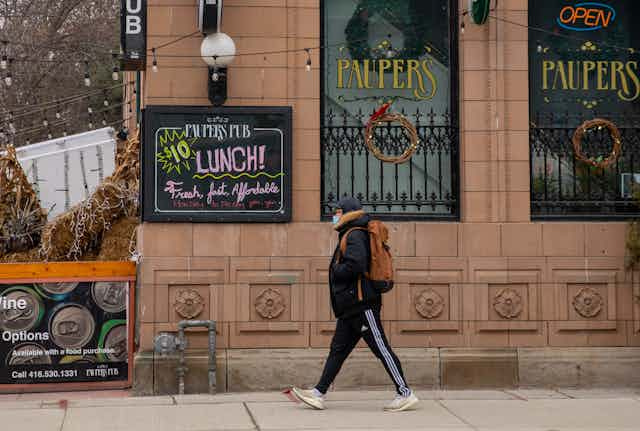On May 1, Toronto announced that 40 per cent of the city’s adult population had received at least one dose of COVID-19 vaccine. This positive public health milestone — signalling progress on vaccinations following a slow and bungled start — lends hope to the notion that urban life in Toronto will rise again as current pandemic restrictions are eventually permitted to diminish.
At the outset of the pandemic 13 months ago, I first wrote about the role that cities were playing at the front lines of coronavirus response. In April 2020, cities were focused on preparing an immediate response to both COVID-19 and pandemic-induced lockdowns.
Toronto’s municipal government was tasked not only with leading an extensive public health response, but also managing a set of rapid policy shifts concerning challenges such as homelessness, public realm, public transit service and tax relief.
Last fall, I launched an initiative called Toronto After the First Wave. Intended as a data visualization project, it was inspired by the accessibility of public health information regarding COVID-19, such as the City of Toronto’s dashboard.
Toronto After the First Wave focuses on quantifying the impacts of COVID-19 on the city as a vibrant urban centre. This work has helped to highlight the urban patterns made visible amid the chaos of the pandemic.
Debate regarding the impacts of COVID-19 on cities continues. On the one hand, there has been story after story on the ongoing urban exodus from big cities to more pastoral living, the decline of downtowns and the unlikelihood of returning to work as we knew it.
Conversely, we have also learned that data often tells us something different: cities remain vibrant places and evidence suggests that concentration remains attractive.
The end of cities?
This urgent work was surrounded by broader debates about whether or not COVID-19 was the final provocation that would lead to the demise of cities. At first, the death of cities argument was inspired by incomplete information about the role that cities played as vectors of disease.
Indeed, cities — as places of dense concentrations of people and activities — appeared to be at the heart of the spread of COVID-19, and the centres of a disproportionate number of cases and deaths. Data demonstrates otherwise, however.
What we know now is that urban inequality is at the heart of the problem. This takes the form of overcrowded living arrangements and precarious labour conditions, including a lack of paid sick days, and is compounded by poor public policy decisions.

What we’ve learned can also be divided into two further categories: outcomes we should have expected and those that surprised us.
Expected impacts
First, COVID-19 is an accelerator. At the start of the pandemic, anecdotal evidence leaned towards claims of an urban exodus. Real estate interest in rural areas and small and mid-sized cities grew, cottage country realtors could not meet demand for properties and home sales in the Toronto dropped precipitously.
Read more: The coronavirus pandemic is pushing Canadians out of cities and into the countryside
Although the data is still being collected, preliminary evidence suggests that there is no urban exodus.
Instead, COVID-19 is credited for speeding up household moves outside of the urban core for affordability reasons. Pandemic lockdowns accelerated the process for those with stable or growing incomes and a desire for more space, and often, a private yard.
At the same time, fees paid by applicants to cover the costs of processing development applications in the City of Toronto increased by over 25 per cent in 2020.
In hindsight, it also seems obvious that COVID-19 would exacerbate inequality. Our Toronto case study highlights the uneven impact of employment loss for women. The pandemic also precipitated the collection of race-based data that demonstrates greater job loss, lower wages, and more precarity for racialized individuals.
Toronto data provides evidence that racialized people and those in low-income households are far more likely to contract COVID-19 than others. We now well understand that the K—shaped economic recovery has benefited some sectors while continuing to create hardship in others.
Surprising innovation
At the same time, COVID-19 forced innovative thinking. Our restaurants dashboard shows that more restaurants opened than closed in Toronto (based on data from Yelp) between May and November 2020. This finding is a far cry from earlier claims that the restaurant sector would be devastated as a result of the closure of indoor and outdoor dining for much of the past year.
Job losses in food services are high, and job creation is slow to return. However, the industry has demonstrated remarkable resilience and innovation, pivoting to takeout menus, digital ordering systems and a high reliance on delivery.
Another area where outcomes have been unexpected is in real estate and rental markets. Our report highlights unusual divergence in these two realms, though Toronto’s divergence is very much in line with the experience of other global cities.
Rental markets in nearly every neighbourhood of the city have experienced declining rents. The greatest declines are in downtown neighbourhoods. Of the four neighbourhoods that experienced rent growth, all are outside of the core on the eastern and western edges of the city.
Conversely, home sales — with the exception of condominiums — have experienced growth in prices across the board. Following an initial dip in prices in April 2020, Toronto real estate prices increased by over 13 per cent in 2020.
It’s too soon to arrive at a conclusion while the story of COVID-19 and cities remains a work in progress. Yes, Toronto has suffered. But it remains a vibrant, thriving city with an enduring future.

